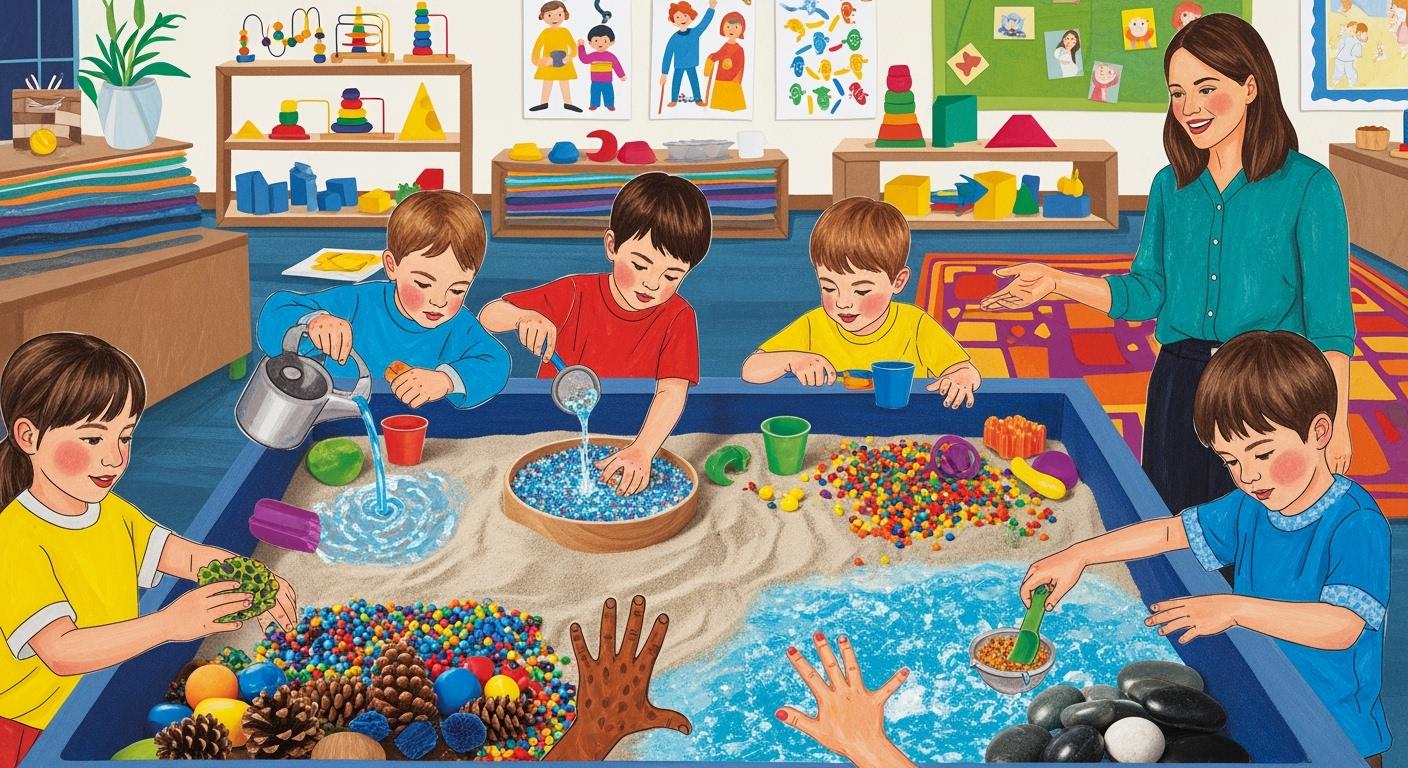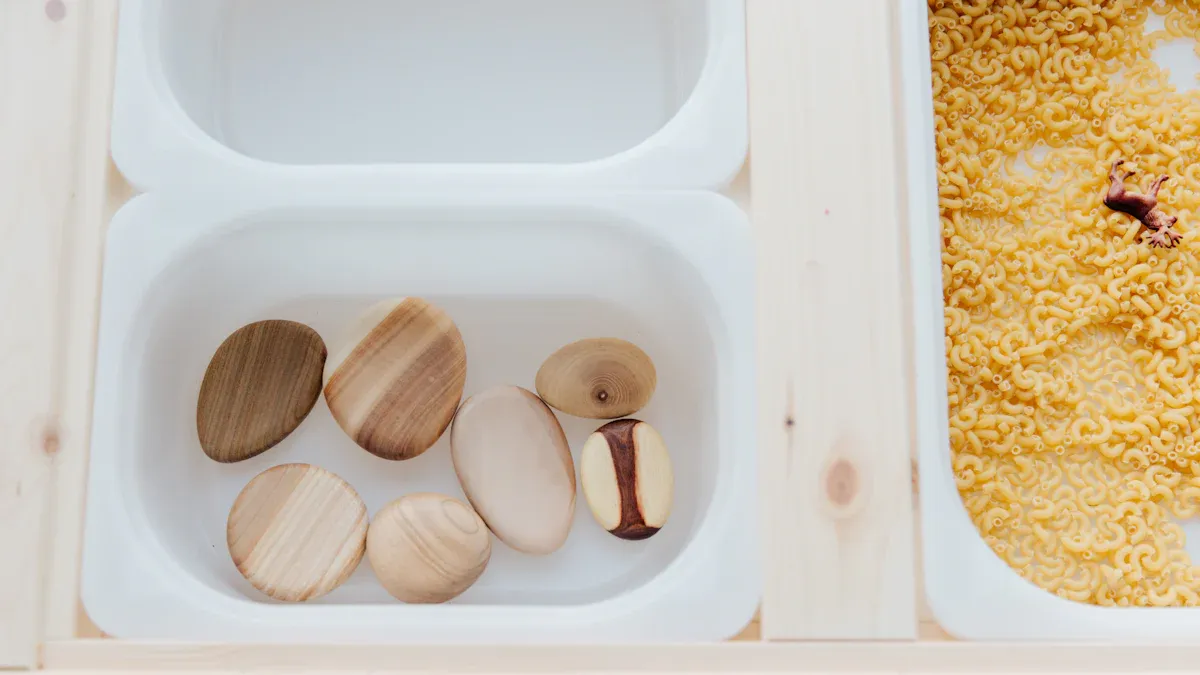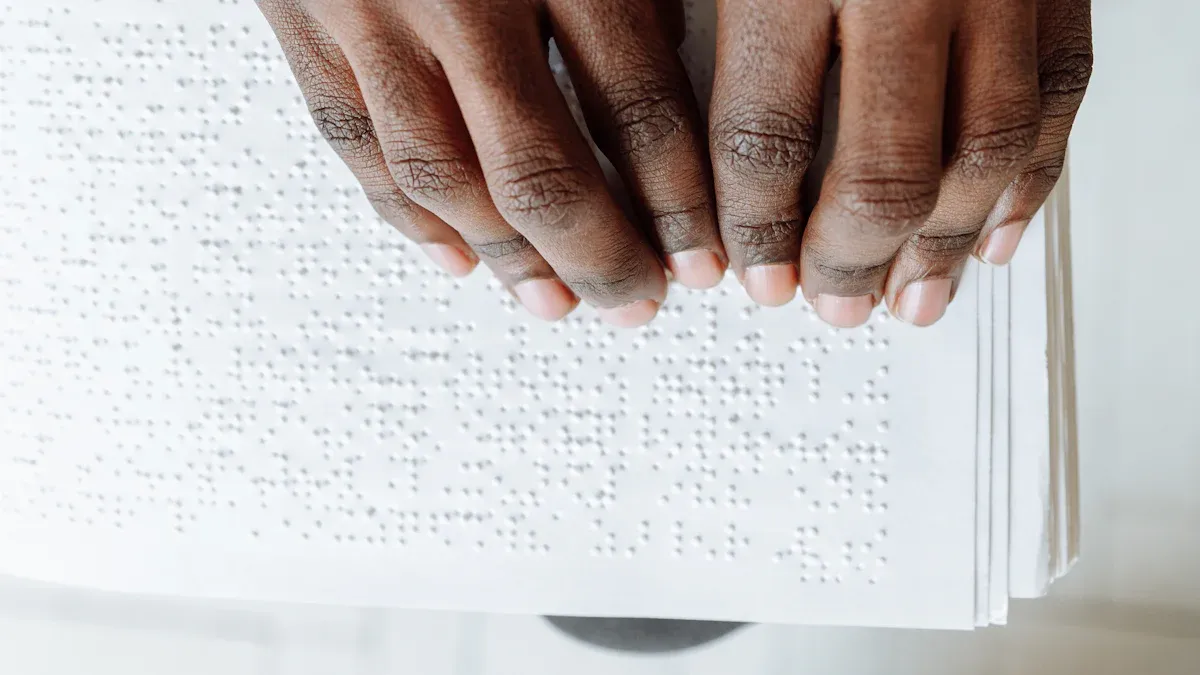Strategies for Sensory Table Success in Classrooms

You can make your classroom more exciting with good sensory tables. You might use a Messy Play Table, a Mood Light Table, a Montessori Light Table, or a Touch Sensor Table. Kids enjoy trying out new textures and things to see. Sensory table ideas help everyone feel like they belong. Leemoland makes sensory tools that help all students learn. If you plan and set up your sensory activities, every student can do their best.
Key Takeaways
Pick sensory tables that can change height and shape. This lets all students use them. Everyone feels welcome and safe.
Use many kinds of materials for the table. These materials should use different senses. Ask students what they like. This makes the space friendly for everyone.
Let students take turns in small groups. This way, everyone gets a chance to play. It also keeps things fun and no one waits too long.
Make simple rules for the sensory area. Put up pictures to remind students of the rules. This helps keep the area safe and neat.
Ask students to help set up and pick activities. This makes them feel proud. It also helps them work together.
Planning Sensory Tables for Groups
Table Size and Layout
When you set up a sensory table, you want everyone to feel welcome. The size of the table matters a lot. If your group is big, pick a table that can change shape or height. Some tables, like the ERGOtable, let you move the height up or down. You can also tilt the table’s surface. This helps students with different needs stay focused. It also lets everyone join in. Flexible seating helps kids work together. It also makes it easy for them to move around. You can make spaces for teamwork or solo play.
Adjustable tables help students sit comfortably.
Flexible layouts help kids work together.
Tilted surfaces help students who need extra support.
Leemoland has many sensory tables and materials for classrooms. You can find tables for small groups or big classes. When you plan your space, think about how students will move. A good setup helps everyone join in and have fun with sensory tables.
Choosing Inclusive Materials
Picking the right materials for your sensory table is important. You want to choose things that interest different senses and learning styles. Start with a sensory checklist. Ask students what they like and what bothers them. You can use reports from therapists or talk to your students. Remember, what students like can change. Always listen and change your materials if needed.
Use different textures, colors, and shapes.
Give choices for students who get overwhelmed.
Respect students’ feelings about sensory problems.
Here is a table of sensory tools for different learners:
Sensory Tool Type | Description | Purpose |
|---|---|---|
Tactile tools | Textured materials, fidget toys | Help students explore by touch |
Proprioceptive activities | Weighted items, climbing structures | Help students learn about their bodies |
Vestibular exercises | Balance boards, rocking chairs | Help students with balance and movement |
Visual distractions | Light tubes, busy boards | Give calming things to look at |
Leemoland makes sensory bin fillers, tactile toys, and visual tools for all students. Sensory table ideas like rice, beans, or water use many senses. These activities help students build motor skills and control their feelings. They also help students become stronger. When you pick materials for everyone, you make sure every child feels included.
Sensory Table Organization
Group Rotations
Every student should get a turn at the sensory table. Group rotations help make this happen. Rotations keep students busy and cut down on waiting. Match activities to the age of your students. Younger kids need easier sensory play. Older students can do more steps. Weekly themes make things fun and help you plan. Let students choose their favorite station or activity. This keeps them interested and gives them control. Students can also help set up a sensory bin. They can explain new activities to others.
Strategy | Description |
|---|---|
Give each group tasks that fit their level. | |
Use weekly themes | Make sensory table ideas exciting and consistent. |
Encourage student choice | Let students pick what they want to do. |
Minimize prep and maximize reuse | Use simple materials again and again. |
Involve students in leadership | Rotate helpers to teach teamwork and responsibility. |
Rules and Expectations
Rules help keep sensory play safe and fun. Go over easy rules, like keeping materials in the table. Remind students to use gentle hands. Tell students to clean up after themselves. Put pictures or signs near the table to remind everyone. Show new words and ask questions about what students see or feel. This helps students learn new words. It also helps them talk about their sensory experiences.
Best Practice | Description |
|---|---|
Review rules like keeping materials in the table and cleaning up. | |
Use visual reminders | Put up signs or pictures to help students remember. |
Encourage language development | Ask questions and teach new words during sensory play. |
Safety and Cleanliness
Safety is very important at the sensory table. Use only non-toxic, food-grade materials. Do not use small objects that could be a choking risk. Watch out for allergens like gluten or dairy in fillers. Always watch students during sensory activities. Remind everyone to wash hands before and after play. Clean and sanitize materials often. Put a mat under the table to catch spills and keep the classroom clean.
Do not use small objects that could cause choking.
Use child-safe, non-toxic materials only.
Check for allergens in sensory bin fillers.
Supervise students every time they play.
Wash hands and clean materials often.
Put a mat under the table for spills.
Tip: Simple materials you can use again save time and money. There are many cheap sensory table ideas for any classroom.
Sensory Table Ideas for Classrooms

You want your classroom to be fun and full of learning. Sensory table ideas can make every day special. You can set up different stations. You can make themed sensory bins. You can plan group activities that include everyone. Leemoland has sensory toys and products. These make activities easy and enjoyable.
Multi-Station Setups
Multi-station setups let you make different areas for sensory play. You can put a light table in one spot. You can place a water table somewhere else. You can add a tactile station with sand or beans nearby. Kids move between stations and try new things. They build new skills as they play. This setup works well for big groups. It keeps everyone interested.
Multi-station sensory table ideas help students talk and move better. Over ten years, schools saw big changes in kids’ behavior. This was true for children with autism who used sensory rooms. Sensory rooms worked better than only traditional therapy.
Sensory-based activities help kids do better in social and learning skills.
Teachers say there are fewer meltdowns and discipline calls after adding sensory rooms.
LED tables help students see differences and process senses. They are popular in multi-station setups.
You can use Leemoland’s LED tables, tactile toys, and sensory bins for your stations. Try mixing rice, beans, and kinetic sand. These textures help kids explore by touch. They learn by playing with their hands.
Themed Sensory Bins
Themed sensory bins make stories and learning exciting. You can fill a bin with water and blue gems for an “ocean” theme. You can use colored rice and toy bugs for a “garden” theme. These sensory table ideas make kids curious and creative.
Sensory activities help students pay attention and stay interested. Kids focus more during sensory play than regular lessons.
Sensory bins let kids play alone or with others. They learn to share and take turns. They work together as a team.
Themed bins help kids make up stories and act out scenes. This helps them learn new words.
Sensory play helps students feel calm and manage their feelings.
Sensory bin activities teach teamwork and working together.
Leemoland’s sensory bin fillers and themed toys make it easy to change your bins. You can use beans, rice, water, or mix colors for more fun. These materials are safe and easy to clean. You can change your bins often.
Collaborative Activities
Collaborative activities at the sensory table help kids learn social skills. You can ask students to build a sandcastle together. They can mix colors in water or sort objects by texture. These sensory table ideas teach kids to talk and solve problems as a group.
Activity | Social Skill Benefit | Emotional Benefit |
|---|---|---|
Group play at the sensory table | Helps kids show feelings and handle frustration | |
Exploring objects together | Helps kids interact with friends | Helps kids express emotions |
Parallel play at a water table | Builds friendships and social skills | Helps kids learn new words |
You can use Leemoland’s sensory toys for group play. Try building with sand, mixing colors, or making textures with different things. These activities help kids think creatively and use their hands.
Activity | Creative Development Benefits |
|---|---|
Building structures with sand | |
Mixing colors with water | Lets kids experiment with art and color |
Creating textures with various materials | Helps kids explore senses and try new ideas |
Activity | Developmental Benefits |
|---|---|
Manipulating materials | Improves hand skills and coordination |
Scooping and pouring | Makes small muscles stronger for writing |
Benefit | Description |
|---|---|
Cognitive Development | |
Language Acquisition | Helps kids learn new words by playing |
You can see how sensory table ideas help students grow in many ways. They learn to work together and solve problems. They learn to express themselves. Sensory bins and group activities make your classroom a place where every child can do well.
Tip: Change your sensory bins and stations often. New materials and themes keep students excited and ready to learn.
Adapting for Diverse Sensory Needs

Leemoland understands that every child is different. You want all students to feel included at the sensory table. Some children, like those with Autism or ADHD, need extra help. Small changes can help everyone join in and have fun. These changes also help kids learn and grow.
Modifications by Age and Ability
You can change sensory table materials for different ages and skills. Younger kids might like soft sand or water for play. Older students may enjoy sorting beans or building with blocks. Some kids need more time to try things. Others like to switch activities quickly. Give students choices and let them decide how to play. This helps them feel safe and sure of themselves.
Here are ways sensory table changes help all students:
Support Type | Benefit for Students |
|---|---|
Tactile Exploration | Helps with hand skills and open play |
Visual Stimulation | Makes kids pay attention and join in |
Social Interaction | Helps kids work together and share |
Calming Benefits | Lowers stress and gets kids ready to learn |
Language Development | Teaches new words for textures and colors |
Studies show students feel less stress when they control the materials. They act better and focus more during sensory play. Social skills also get better.
Supporting Sensitivities
Some students get upset by loud sounds, bright lights, or strong smells. You can make a quiet area or calm spot in your classroom. Add soft chairs, fidget toys, or headphones that block noise. Use plain colors and simple decorations to avoid distractions. Put sensory items in clear bins with labels. This helps students know what is inside and feel less worried.
Let students take movement breaks or play outside to help their senses. Flexible seats, like wobble cushions or bean bags, help students stay comfy. Planning for sensitivities makes early childhood education better for everyone.
Tip: Keep sensory table time fun by letting students pick activities and change materials often. This keeps everyone happy and helps them learn.
Tips for Ongoing Sensory Success
Student Involvement
Letting students help with sensory table activities makes class more fun. When students help set up or clean, they feel proud. They also feel like they matter. You can ask them to pick materials or suggest new themes. Some students can even lead a small group. This teamwork helps everyone feel included. It also builds confidence.
Ask students to pick their favorite tactile tools or sensory bin fillers.
Let students take turns helping set up and clean.
Encourage students to share ideas for new activities or themes.
Giving students a say keeps them interested in sensory play. It helps them learn to work together and build social skills.
You can use checklists to see how students grow in social skills. Many teachers see better focus and fewer problems when students join sensory activities. Using tactile tools like sand trays or fidget toys helps students stay calm. It also helps them get ready to learn.
Refreshing Activities
Changing sensory table activities often is important for success. If you switch things up, students will be excited each time. Try rotating stations or adding new games to keep things fun.
Activity Type | Description | Benefits |
|---|---|---|
Parachute Play | Move a big parachute up and down for soothing feelings. | Helps kids explore senses and move their bodies. |
Non-Competitive Games | Play games like blowing bubbles or tag with friends. | Builds teamwork and lowers stress. |
Team-Building Games | Try group games like the human knot for solving problems. | Helps kids talk and work together. |
Station Rotation | Let students move between different sensory stations. | Keeps things interesting and gives choices. |
You can add new textures, colors, or themes every few weeks. Ask students what they want to try next. This keeps class fun and everyone curious. You can talk to specialists or read about sensory strategies online. Learning new ideas helps your sensory table program stay strong all year.
You can make your classroom fun for every child. Careful planning helps students learn and feel good. Sensory activities let kids grow and do well. Using Leemoland’s solutions helps students control their feelings. It also lowers stress and helps kids make friends. Look at the benefits in the table below:
Benefit | Description |
|---|---|
Promotes Self-Regulation | Helps children handle feelings and actions. |
Reduces Anxiety | Gives calm places that help kids worry less. |
Develops Social Skills | Lets kids play together and build teamwork. |
FAQ
What materials work best for sensory tables?
You can use rice, beans, water, or sand. Safe sensory toys are good too. Leemoland has many choices for you. Try using different textures and colors together. Always check for allergies before starting.
How do you keep sensory tables clean?
Wipe the table after each use. Wash hands before and after playing. Use mats to catch any spills. Leemoland’s sensory toys are simple to clean and sanitize.
Can sensory tables help kids with Autism or ADHD?
Yes! Sensory tables help kids focus and feel calm. They also help with social skills. Leemoland makes toys for kids with Autism, ADHD, and learning needs. You can change activities so every child can join.
How often should you change sensory table activities?
Change activities every week or two. Ask students what they want to try next. New themes and materials keep everyone happy and interested.
What safety tips should you follow?
Always watch students during play.
Use only non-toxic, child-safe materials.
Do not use small things that could cause choking.
Check for allergies before you begin.
See Also
Essential Guidelines for Creating Sensory Rooms in Schools
Key Tools for Educators to Establish Sensory Rooms
Easy Suggestions for Creating a Sensory Corner
Effective Strategies for ASD Sensory Spaces in Schools
Streamlined Approaches to Designing Sensory Classrooms for Teachers
